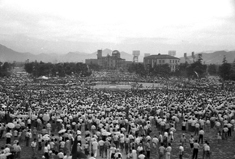Grief and Resolution
People who were barely able to eke out a living each day recalled memories of their deceased families and fellow workers, renewing their grief, as they strived to gradually regain composure in their daily lives. August 6 has become a day when people who were left behind pray for the souls of victims and keep reverence for peace in mind. Around this period, Sasaki visited the Peace Memorial Park each year and photographed those who came offering prayers.
Grieving for A-bomb Victims
In May 1946, the Hiroshima War Victims Consolation Association (later changed to the Hiroshima War Disaster Consolation Association) constructed the War Victim Memorial Mound at the north edge of the present-day Peace Memorial Park. In July that year, the vault and place of worship were completed, at which unidentified ashes were officially interred that had been in storage since immediately after the A-bombing. Memorial towers were constructed by workplaces, schools and areas in places such as neighboring areas of the hypocenter, where many lives had been sacrificed in building demolition works; as well as at the former sites of emergency first-aid stations and crematories.
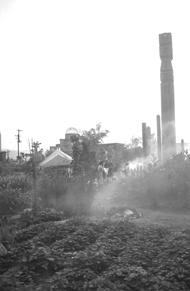
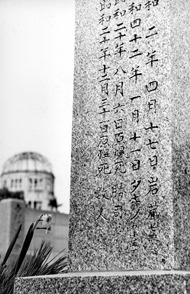 |
War Victim Memorial Mound1950 Nakajima-choThe Hiroshima War Victims Consolation Association, which was inaugurated in January 1946, collected donations and constructed a temporary crypt and memorial mound in Jisenji-no-hana (at the north edge of the present-day Peace Memorial Park) in the spring of 1946. |
|||
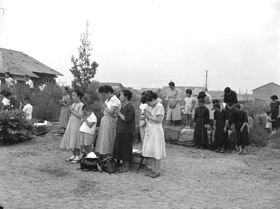 Bereaved families visiting from distant places1951 Nakajima-choOffering silent prayers in front of the War Victim Memorial Mound. Traveling bags at their feet show that they are bereaved families from distant places. |
||||
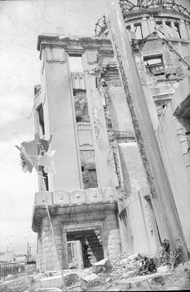 |
||||
Gravestone1967 Ote-machi 1-chomeCharacters meaning “died in the A-bombing” are inscribed on this gravestone. These characters convey the tragedy of precious lives being suddenly taken away. |
||||
Memorial standing at the A-bomb Dome (Right)1952 Ote-machi 1-chomeA memorial for the staffers of the Interior Ministry Chugoku-Shikoku Public Works Office, who were engaged in clerical work at the time of the A-bombing. In 1954, a stone monument with an engraved elegy was erected. |
||||
Ashes are still....
As the city’s reconstruction advanced at construction sites of facilities such as Peace Memorial Park, ashes were frequently unearthed from scorched ground layers. These ashes were placed in the Atomic Bomb Memorial Mound one after another, along with ashes that had been buried immediately after the A-bombing and dug up later. Although most of these unearthed ashes were “name unknown,” some ashes were unclaimed even if their names had been identified. Hiroshima City sought information on persons with connection to these ashes by releasing to the public the Atomic Bomb Memorial Mound’s list of ashes and list of deceased victims.
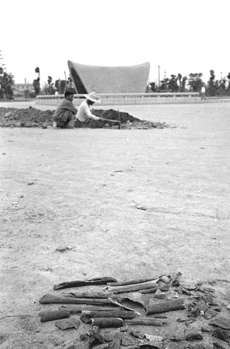 Remains being unearthed from the Peace Memorial Park1955 Nakajima-choDuring the construction of the Peace Memorial Park, many remains were unearthed along with fragments of table wares and household goods which had been scorched black. This renewed our memories of a once-thriving town where many people had formerly lived. |
Remains exposed on the riverbed1948 Motoyasugawa RiverThe Peace Tower, seen from the east bank of the Motoyasugawa River. The tower was built for the Peace Festival conducted on August 6. Three years after the A-bombing, remains were found on the riverbed.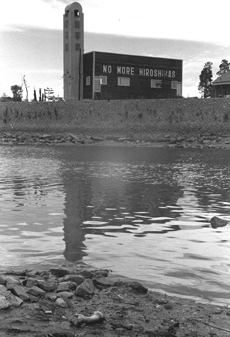 |
Family Reunion after 23 Years
1968 Nakajima-cho |
||||
 (1) On July 20, this woman found the name of her son, whom she had lost in the A-bombing 23 years before, during a public viewing of the list of the Atomic Bomb Memorial Mound’s ashes. |
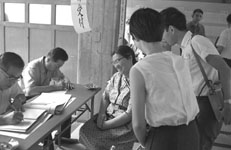 (2) Being interviewed by the media during the process of receiving ashes. |
|||
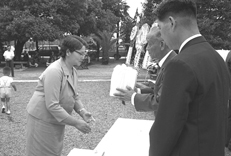 (3) On August 1, the bereaved received ashes in front of the Atomic Bomb Memorial Mound. |
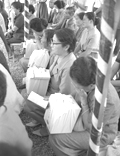
|
(4) Holding her son’s ashes on her lap, the woman at the center didn’t shed tears until the end of the ceremony. | ||
August 6
On August 5, at the Citizens Plaza in Moto-machi, the “Hiroshima Citizens’ Rally for the Reconstruction of Peace” was held, attracting about 7,000 residents. On August 6, 1947, at the Peace Plaza, across the river from the A-bomb Dome, the first “Hiroshima Peace Festival” was held. This festival was held three years in a row, until 1949. Although the Peace Festival in 1950 was canceled due to the rally prohibition issued by the occupation forces, in 1951 the festival was revived as the “Hiroshima Peace Memorial Ceremony.” From 1952, the festival was held in front of the Cenotaph for the A-bomb Victims, and then later taken over by the present-day version of the “Hiroshima Peace Memorial Ceremony.”
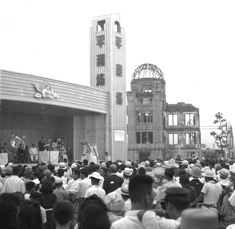 The 1st Peace Festival1947 Nakajima-choThe 1st Peace Festival was held in front of the Peace Tower located on the river bank across from the A-bomb Dome. Mayor of Hiroshima City read out the Peace Declaration, and a bell was rung at the time the A-bomb was dropped. |
The 3rd Peace Festival1949 Moto-machiIn the design contest for the Peace Memorial Park and memorial hall, a group led by Kenzo Tange, then an assistant professor at the University of Tokyo, won the first prize. The announcement and public acknowledgment of the result was implemented in the 3rd Peace Festival.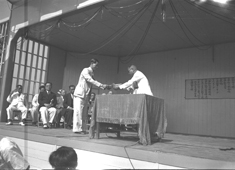 |
|
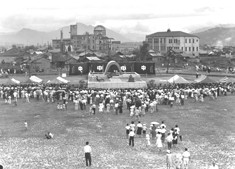 Peace Memorial Ceremony held in front of the Cenotaph for the A-bomb Victims1952 Nakajima-choThe first Peace Memorial Ceremony, held in front of the Cenotaph for the A-bomb Victims. The number of the attendants was roughly 1,000. Banners were hung between the cenotaph and shacks at the back. |
Peace Memorial Ceremony with an increased number of participants
/h2>
|

